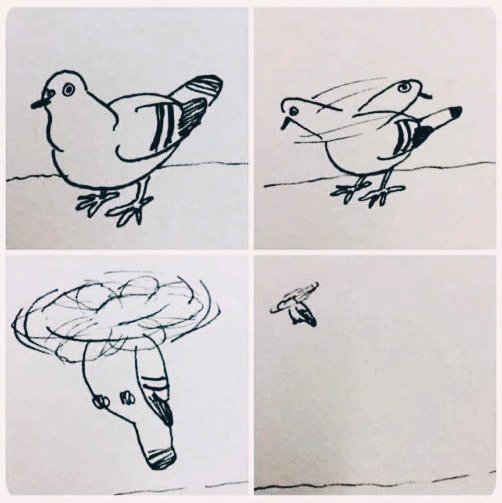티스토리 뷰
코랩 실습파일)
beginner.ipynb
Run, share, and edit Python notebooks
colab.research.google.com
깃허브 소스)
GitHub - tensorflow/docs-l10n: Translations of TensorFlow documentation
Translations of TensorFlow documentation. Contribute to tensorflow/docs-l10n development by creating an account on GitHub.
github.com
* Keras를 사용하여 수행.
- 사전에 빌드한 데이터 세트 로드
- 이미지를 분류하는 신경망 머신러닝 모델 빌드
- 해당 신경망 훈련
- 모델의 정확도 평가
1. TensorFlow 설정하기
import tensorflow as tf
print("TensorFlow version:", tf.__version__)
# colab에서 실행하면 최신버전으로 실행 가능합니다.
2. 데이터셋 로드하기
mnist = tf.keras.datasets.mnist
(x_train, y_train), (x_test, y_test) = mnist.load_data()
print(x_train[0].shape)
x_train, x_test = x_train / 255.0, x_test / 255.0
>> (28, 28)
import matplotlib.pyplot as plt
idx=5
plt.imshow(x_train[idx])
plt.title(y_train[idx])
>> Text(0.5, 1.0, '2')
# 2차원 데이터는 신경망에 주입을 할 수 없다.
x_train[0].shape
>> (28, 28)
# 신경망에 주입하기 위해 1차원 형태로 변형한다.
# flatten()
x_train[0].flatten().shape
>> (784, )
x_train[0].flatten()
>> array([0. , 0. , 0. , 0. , 0. , ... ])
3. 머신러닝 모델 빌드하기
층을 차례대로 쌓아 tf.keras.Sequential 모델을 만듭니다. 훈련에 사용할 옵티마이저(optimizer)와 손실 함수를 선택합니다.
model = tf.keras.models.Sequential([
tf.keras.layers.Flatten(input_shape=(28, 28)),
tf.keras.layers.Dense(128, activation='relu'),
tf.keras.layers.Dropout(0.2),
tf.keras.layers.Dense(10, activation='softmax')
])
model.compile(optimizer='adam',
loss='sparse_categorical_crossentropy',
metrics=['accuracy'])각 예시에서 모델은 각 클래스에 대해 하나씩, logits 또는 log-odds 스코어 벡터를 반환합니다.
predictions = model(x_train[:1]).numpy()
predictions
>> array([[0.07470351, 0.08945837, 0.06401815, 0.09958632, 0.06803247,
0.17370385, 0.10852029, 0.0912534 , 0.09243535, 0.13828829]],
dtype=float32)tf.nn.softmax 함수는 다음과 같이 이러한 로짓을 각 클래스에 대한 확률로 변환합니다.
tf.nn.softmax(predictions).numpy()
>> array([[0.09745193, 0.09890047, 0.09641616, 0.09990722, 0.09680399,
0.10759342, 0.10080379, 0.09907816, 0.09919534, 0.10384963]],
dtype=float32)
tf.nn.softmax(predictions).numpy().sum()
>> 1.0
import numpy as np
np.argmax(tf.nn.softmax(predictions).numpy())
>> 5
참고: tf.nn.softmax 함수를 네트워크의 마지막 레이어에 대한 활성화 함수로 베이킹할 수 있습니다.
이렇게 하면 모델 출력을 더 직접적으로 해석할 수 있지만 이 접근법은 소프트맥스 출력을 사용할 경우
모든 모델에 대해 정확하고 수치적으로 안정적인 손실 계산을 제공하는 것이 불가능하므로 권장하지 않습니다.losses.SparseCategoricalCrossentropy를 사용하여 로짓의 벡터와 True 인덱스를 사용하고 각 예시에 대해 스칼라 손실을 반환하는 훈련용 손실 함수를 정의합니다.
loss_fn = tf.keras.losses.SparseCategoricalCrossentropy(from_logits=True)이 손실은 실제 클래스의 음의 로그 확률과 같습니다. 모델이 올바른 클래스를 확신하는 경우 손실은 0입니다.
이 훈련되지 않은 모델은 무작위에 가까운 확률(각 클래스에 대해 1/10)을 제공하므로
초기 손실은 -tf.math.log(1/10) ~= 2.3에 근접해야 합니다.
loss_fn(y_train[:1], predictions).numpy()
>> 2.2293959훈련을 시작하기 전에 Keras Model.compile을 사용하여 모델을 구성하고 컴파일합니다.
optimizer 클래스를 adam으로 설정하고 loss를 앞에서 정의한 loss_fn 함수로 설정합니다.
metrics 매개변수를 accuracy로 설정하여 모델에 대해 평가할 메트릭을 지정합니다.
model.compile(optimizer='adam',
loss=loss_fn,
metrics=['accuracy'])
4. 모델 훈련 및 평가하기
model.fit(x_train, y_train, epochs=5)Model.evaluate 메서드는 일반적으로 "Validation-set" 또는 "Test-set"에서 모델 성능을 확인합니다.
model.fit(x_train, y_train, epochs=5)
model.evaluate(x_test, y_test, verbose=2)훈련된 이미지 분류기는 이 데이터셋에서 약 98%의 정확도를 달성합니다.
모델이 확률을 반환하도록 하려면 다음과 같이 훈련된 모델을 래핑하고 여기에 소프트맥스를 첨부할 수 있습니다.
probability_model = tf.keras.Sequential([
model,
tf.keras.layers.Softmax()
])
probability_model(x_test[:5])
>> <tf.Tensor: shape=(5, 10), dtype=float32, numpy=
array([[0.08533801, 0.08533801, 0.08533802, 0.08534664, 0.08533801,
0.08533801, 0.08533801, 0.2319492 , 0.08533801, 0.08533803],
[0.08533675, 0.08533677, 0.23196921, 0.08533676, 0.08533675,
0.08533678, 0.08533675, 0.08533675, 0.08533675, 0.08533675],
[0.08534387, 0.23185657, 0.08536338, 0.08534395, 0.08534426,
0.0853439 , 0.08534405, 0.08536484, 0.0853513 , 0.08534387],
[0.23196821, 0.08533681, 0.0853372 , 0.08533682, 0.08533681,
0.08533681, 0.08533683, 0.08533683, 0.08533681, 0.08533685],
[0.0853756 , 0.08537558, 0.08537596, 0.08537558, 0.23135364,
0.08537558, 0.08537566, 0.08537634, 0.08537558, 0.08564048]],
dtype=float32)>
'TIL & WIL > Deep Learning' 카테고리의 다른 글
| CNN 간단히 알아보기 (0) | 2023.04.17 |
|---|---|
| ✨ 딥러닝 : 인공신경망 및 과정 (0) | 2023.04.11 |
| TensorFlow - Regression 실습 (1) 선형회귀 (0) | 2023.04.11 |
| TensorFlow - Classification 실습 (0) | 2023.04.11 |
| ✨ 딥러닝 기초 (1) | 2023.04.11 |
